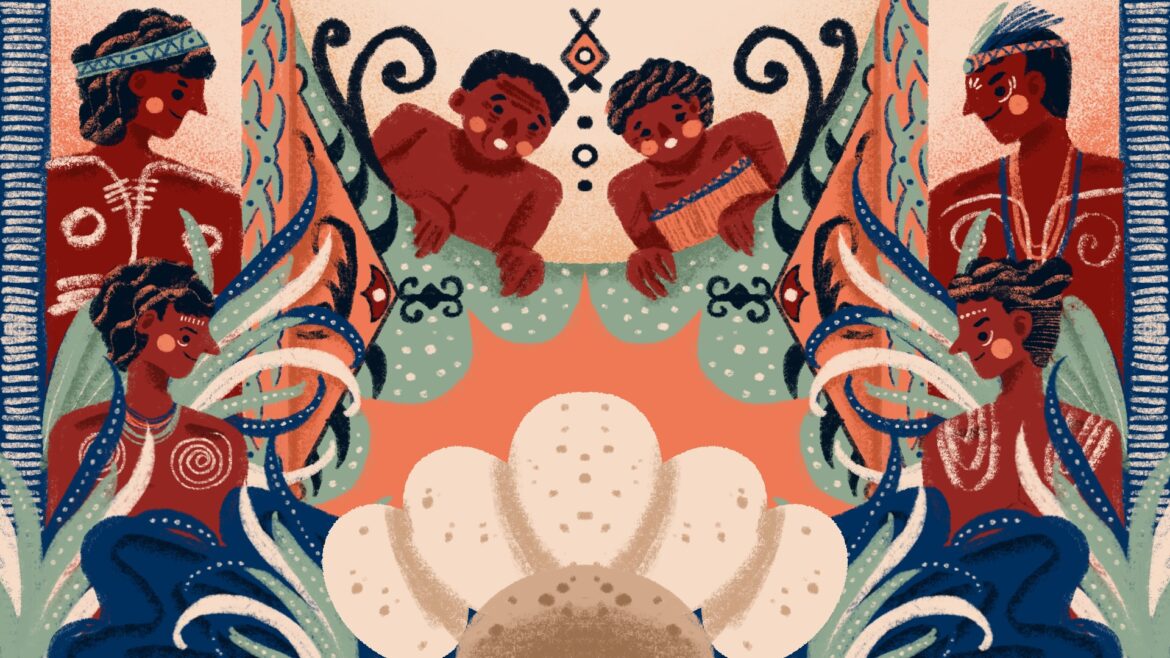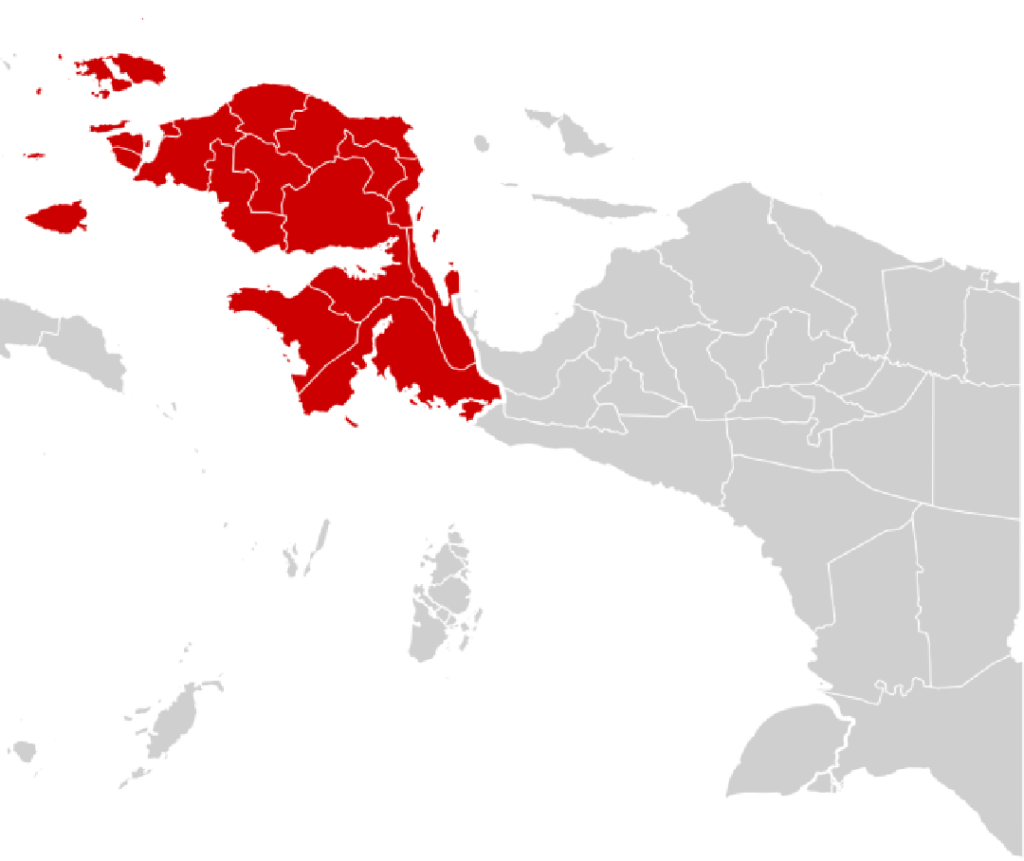Far beyond the turquoise shallows and coral cathedrals of Raja Ampat lies a legend whispered by the wind, carried by river spirits, and etched into stone. Long before tourists discovered this Indonesian archipelago as a paradise for divers and photographers, the people of Papua spoke of a time when four kings rose from a divine origin—hatched not from royal lineage but from sacred eggs.
This is the myth behind the name Raja Ampat, meaning “Four Kings.” It is a tale passed down through generations, encoded in the traditions of local tribes, remembered in rituals, and enshrined in sacred sites still honored today. This is not just the story of a name—it is the soul of a people and the sacred geography that shaped them.
The Forest, the River, and the Discovery
Long ago, in the heart of the Papuan rainforest near the banks of what is now known as the Waikeo River, a humble couple lived in harmony with nature. The man and his wife, whose names have faded into the mist of legend, were foragers—simple people who relied on the bounty of the jungle.
One day, while exploring near a quiet bend in the river, the woman stumbled upon something extraordinary: seven large eggs, smooth, glowing faintly, and unlike any bird or reptile egg she had ever seen. She carefully wrapped them in banana leaves and brought them home to her husband. The couple, awestruck by the beauty and mystery of the eggs, decided to guard them with care.
What happened next would forever alter the course of their lives—and the future of the region.
The Hatching of Kings
In time, the eggs began to hatch. From the first four eggs emerged four infant boys, each radiating an aura of power and destiny. The villagers, who had come to hear of the miraculous discovery, gathered in awe. These children, it was said, were not born of flesh and blood but were gifts from the sky, the forest, and the ancestors.
As they grew, it became clear that these were no ordinary children. Each boy displayed distinct qualities of leadership, wisdom, and strength. In time, they would grow into the four great kings, each destined to rule one of the largest islands in what is now the Raja Ampat archipelago:
- War became the king of Waigeo.
- Betani ruled over Batanta.
- Dohar was crowned in Salawati.
- Mohamad reigned over Misool.
These four kings would bring governance, order, and connection to their islands, and their spiritual link to the land would never be forgotten.
The Other Eggs: A Sacred Daughter and the Egg of Stone
But what of the remaining three eggs?
From the fifth egg, a girl was born, a striking beauty named Pintolee (or variations of this name in local dialects). Her story, though less known than that of her royal brothers, holds equal weight in the lore. Pintolee, according to the oral tradition, fell in love with a man deemed unsuitable by her divine brothers. To protect their honor or perhaps out of jealousy, they forbade the union.
Refusing to surrender to her brothers’ authority, Pintolee escaped. With the help of forest spirits or sea creatures—depending on the version of the tale—she fled aboard a giant shell, carried across the ocean to the island of Numfor. Her story is a parable of love, rebellion, and sacrifice, a reminder that even divine blood cannot cage a free heart.
The sixth egg, however, never hatched.
Instead, it turned to stone. This was no ordinary stone, but one that retained the sacred essence of its origin. It became known as Kapatnai, the “King’s Egg,” and was enshrined in a sacred house near the Waikeo River. The site remains one of deep spiritual significance, protected and maintained by the descendants of the original villagers. Every year, the stone is ritually bathed, adorned, and honored—not merely as a relic, but as a living ancestor.
The seventh egg, in some versions, either vanished, remained hidden, or is said to have birthed a spiritual being—a guardian or ghost that roams the forest or sea, ensuring the land remains protected from outsiders who show disrespect.
The Sacred Site of Kali Raja
Near the river where the eggs were first discovered stands Situs Kali Raja, a quiet, heavily forested site where the sacred egg-stone is housed. The surrounding area features two megalithic stones, known as Man Moro and Man Metem, believed to be guardians or ancestral sentinels of the divine children.
Visitors are not allowed to touch or photograph the sacred egg without permission from tribal elders, and only descendants of the four kings are allowed to perform the traditional rituals that keep the site spiritually “clean.” To the local people, this is not mythology—it is their living cosmology.
Layers of the Legend: Variants and Interpretations
What makes the Raja Ampat myth particularly fascinating is its fluidity. Like many oral traditions, it shifts from island to island, tribe to tribe, and elder to elder. In some accounts, the eggs were found not by a couple but by a lone hunter. In others, there are six eggs instead of seven. One version adds an eighth figure—a ghost-like woman who never fully emerged from her shell.
Still, the core narrative remains intact: four eggs, four kings, born not of human union but divine intent. They emerged to rule with wisdom, to guide with strength, and to guard a land that would one day become one of the world’s most biodiverse sanctuaries.
From Legend to Legacy
Though the legend of the four kings might seem mythical, it has a historical resonance as well. During the time of the Tidore Sultanate, the islands now called Raja Ampat were indeed ruled by four local chieftains, each governing a major island. These kings paid tribute to Tidore while retaining control over their domains—suggesting that the legend might be a mythologized memory of political history.
Some scholars believe the legend was born from this historic reality, transformed over generations into a sacred tale. But for the people of Raja Ampat, the question is not whether the eggs were real, but whether the spirit of the kings still lives on—and in that, they have no doubt.
The Modern Meaning of an Ancient Name
Today, Raja Ampat is known across the world for its incomparable marine biodiversity—home to 75% of the world’s coral species, over 1,600 species of reef fish, and majestic manta rays that glide through sapphire waters.
Yet, beneath the waves and behind the landscapes, it is the story of the Four Kings that truly gives this place its soul. Tourists may come for the snorkeling, but they leave touched by something deeper—the feeling of sacredness, of being in a land where nature and myth are one and the same.
Why the Myth Still Matters
In an era dominated by technology and rapid modernization, the myth of Raja Ampat serves as a powerful reminder of the human need for stories, especially those rooted in place, land, and lineage. The tale of the seven eggs is not just about kingship; it’s about origin, purpose, and spiritual responsibility.
It teaches that true leadership is born not only from power but also from connection—to the land, to the people, and to the unseen forces that shape our world.
Conclusion
As the sun sets behind the limestone cliffs of Waigeo and the sea hushes into silence, one can almost hear the voices of the ancestors rising with the mist. They whisper of a woman who found seven eggs by a river. Of kings who ruled wisely. Of a sister who chose freedom. Of a stone that remembers.
In Raja Ampat, the legend is still alive. And the Four Kings still reign—in story, in spirit, and in the hearts of the people.


